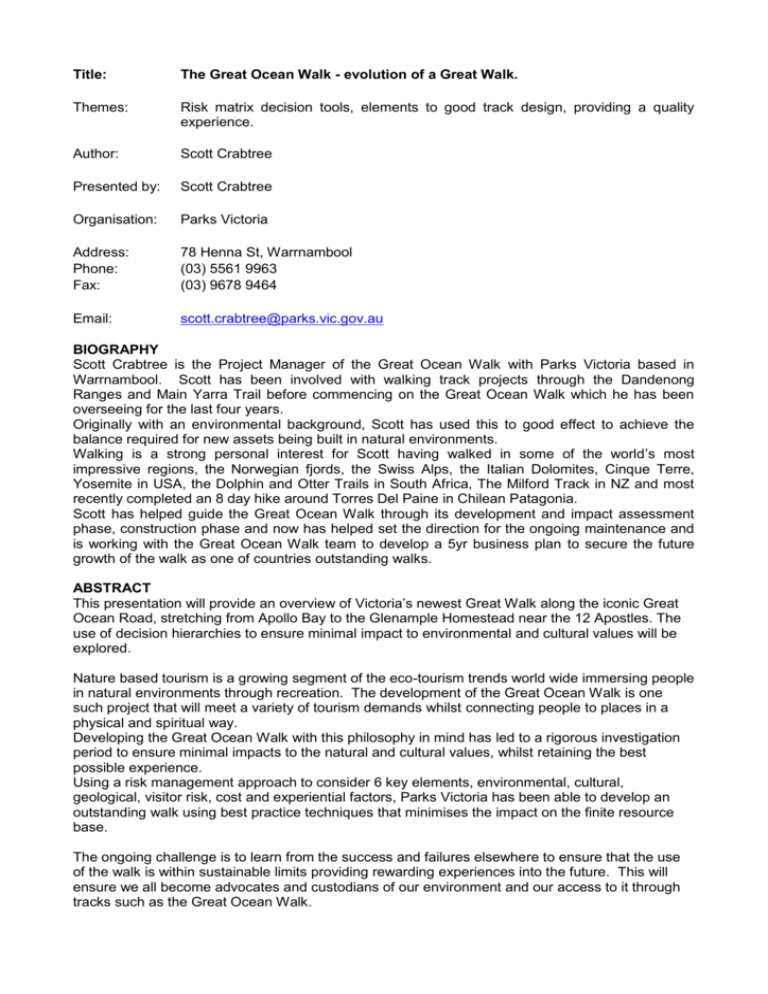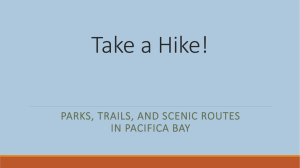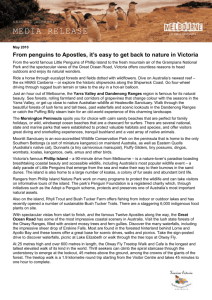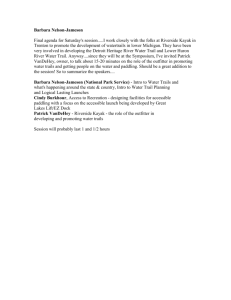83kb doc
advertisement

Title: The Great Ocean Walk - evolution of a Great Walk. Themes: Risk matrix decision tools, elements to good track design, providing a quality experience. Author: Scott Crabtree Presented by: Scott Crabtree Organisation: Parks Victoria Address: Phone: Fax: 78 Henna St, Warrnambool (03) 5561 9963 (03) 9678 9464 Email: scott.crabtree@parks.vic.gov.au BIOGRAPHY Scott Crabtree is the Project Manager of the Great Ocean Walk with Parks Victoria based in Warrnambool. Scott has been involved with walking track projects through the Dandenong Ranges and Main Yarra Trail before commencing on the Great Ocean Walk which he has been overseeing for the last four years. Originally with an environmental background, Scott has used this to good effect to achieve the balance required for new assets being built in natural environments. Walking is a strong personal interest for Scott having walked in some of the world’s most impressive regions, the Norwegian fjords, the Swiss Alps, the Italian Dolomites, Cinque Terre, Yosemite in USA, the Dolphin and Otter Trails in South Africa, The Milford Track in NZ and most recently completed an 8 day hike around Torres Del Paine in Chilean Patagonia. Scott has helped guide the Great Ocean Walk through its development and impact assessment phase, construction phase and now has helped set the direction for the ongoing maintenance and is working with the Great Ocean Walk team to develop a 5yr business plan to secure the future growth of the walk as one of countries outstanding walks. ABSTRACT This presentation will provide an overview of Victoria’s newest Great Walk along the iconic Great Ocean Road, stretching from Apollo Bay to the Glenample Homestead near the 12 Apostles. The use of decision hierarchies to ensure minimal impact to environmental and cultural values will be explored. Nature based tourism is a growing segment of the eco-tourism trends world wide immersing people in natural environments through recreation. The development of the Great Ocean Walk is one such project that will meet a variety of tourism demands whilst connecting people to places in a physical and spiritual way. Developing the Great Ocean Walk with this philosophy in mind has led to a rigorous investigation period to ensure minimal impacts to the natural and cultural values, whilst retaining the best possible experience. Using a risk management approach to consider 6 key elements, environmental, cultural, geological, visitor risk, cost and experiential factors, Parks Victoria has been able to develop an outstanding walk using best practice techniques that minimises the impact on the finite resource base. The ongoing challenge is to learn from the success and failures elsewhere to ensure that the use of the walk is within sustainable limits providing rewarding experiences into the future. This will ensure we all become advocates and custodians of our environment and our access to it through tracks such as the Great Ocean Walk. Paper: Introduction: Great walks don’t just happen, they require an idea, a shared vision, committed people, integrity of purpose, a good location, determination and a thick skin! Greatness should not be measured by the scale, length or other such attributes but rather the ability to render the user a memorable and rewarding experience. This experience must be provided without compromising the environment and it must be long lasting! This is the journey of the Great Ocean Walk. Recognition of past use: I would like to recognise the lands the Great Ocean Walk traverses as the traditional lands of the Gadabanud people. These areas, rich and diverse in plant and animal life have been gathering, ceremonial and feasting places for thousands of years, with many sites and spiritual links remaining today. History: First conceived in the 1970’s an idea for a coastal walk along the west coast of Victoria grew and became the Great Ocean Walk through the efforts of passionate community members. Bill Bowker was one of the early champions, who advocated, enthused, motivated and brought others on board. Bill’s role was critical in developing a vision and setting people on the evolutionary journey of the Great Ocean Walk. His enthusiasm brought together a group of community members, accommodation providers, local government and Parks Victoria staff. The group refined the concept for the Great Ocean Walk and were successful in obtaining the first round of funding for the walk from the federal tourism department in the mid 90’s. Subsequently Parks Victoria as the land manager also committed some funding towards preliminary risk assessments. It was at this point that the process for building a walking track changed from the more conventional approach. The conventional approach is to mark a track and then investigate the impacts. In fact that approach was the initial approach and track construction was undertaken by a conservation program under supervision by Parks Victoria. The work was completed under duress with one of the wettest winters on record and under severe time constraints and with a paucity of detailed planning. With the tourism industry strongly behind the project, the peak conservation bodies in the state lobbied for greater scrutiny of the project associated with any further funding. Funding was secured on the proviso that Parks Victoria could prove that it was possible to construct a walk that was environmentally sustainable. Vision: Vision: An outstanding coastal walk experience linked to accommodation and transport. The Great Ocean Walk trail system aims to be environmentally sound, culturally sensitive, financially rewarding to local communities providing social, recreation, health benefits and a high quality, sustainable nature-based walking icon for the state of Victoria. Located between the scenic coastal towns of Apollo Bay and Port Campbell, finishing at Glenample Homestead near the 12 Apostles, the 91km walk is chiefly an 8 day 7 night experience with the system allowing also for short walks and overnight segments to be completed. The primary route traverses the deeply dissected mountain forests and spectacular coastal margin of the Otway Ranges and Otway Plain through the Otway and Port Campbell National Parks, Coastal reserves and road reserves. It is an incredibly scenic and beautiful heritage landscape. This section of coast along the renowned Great Ocean Road, provided the best opportunity to provide an outstanding walking experience. The Great Ocean Road deviates inland providing a greater sense of isolation for the hiking track in this part of the coast. One of the key features that the Great Ocean Walk offers and its key differentiation from other walks in the state is the ability to link the walk to existing and future accommodation located on adjoining private land. Transport of walkers and baggage, secure parking, the provision of food and tours are all additional components that will make the walk truly unique and world class. There is a latent walking market in Australia and particularly Victoria, comprising people that like the idea of going on a walk but are looking for comfort at the end of a day to recharge. This market is being catered for exceptionally well by walks such as the Milford track and Overland track and other walks throughout Europe. Principles Leon Hugo, a professor in geography at the University of Pretoria in South Africa was engaged to help Parks Victoria develop a framework that would allow all of the necessary information, to be collated to make decisions on the suitability and location of the walk. This was a critical step in assessing the environmental sustainability of the walk, a key government milestone to be met for the project to proceed. Leon brought a wealth of expertise and experience to the project but one of the most important things he instilled was the need to understand the purpose of the track and that it should be developed upon ecotourism principles. His passion for this was not political; however the governments of the day were also pushing for triple bottom line outcomes which can be closely aligned to these principles. These principles helped to refine the vision and objectives for the walk, in particular the focus on eco, rather than just tourism. The principles are: QualityTouri sm experience ECOTOURISM Host community benefits Principle 1 - Quality experience for the tourist, and hiker Principle 2 - Protection of the Landscape, Natural and Cultural Resources Principle 3 – Plan, develop, implement and manage the tourist product in partnership with the local community to achieve regional economic benefits. Conservatio n of tourism resource base Figure 1.0 Cornerstones of ecotourism (after Hattingh, 1996). Principle 1 – Quality experience It is to be emphasised that the Great Ocean Walk is not to be an icon walk in terms of its magnitude but primarily in terms of the exceptional quality of the enlightening and rewarding experience rendered to the hikers. It is therefore much more than a path along the coast joining two places. Users of the Great Ocean Walk will gain a unique experience and appreciation of the area’s natural and cultural heritage by way of appropriate transfer of information and absorbing the environment around them. For walkers to gain this experience it is critical that accurate and informative messages and images are conveyed to ensure peoples expectations are met. Parks Victoria has recognised that parks offer more than just recreation, leisure, sport and tourism experiences to the community. Parks offer people a means of connecting to the natural environment and the reported benefits are far wider reaching. As humans we are one part of an ecosystem and our environment can provide for our psychological, emotional and spiritual needs. In fact research is indicating that humans are dependant on it, highlighting the need to be part of a life sustaining society. To reflect this Parks Victoria has developed a Healthy Parks, Healthy People message to communicate the importance of parks to the community. Planning for the Great Ocean Walk took on board a similar theme in parallel to the work that Parks Victoria was undertaking. The Great Ocean Walk is now one medium that can enable people to reconnect to our environment and provide a rewarding and memorable experience. Principle 2 – Protection of the landscape, natural and cultural values Exploring Eco a little further: We have modified our environment and the way we live in it to such a large extent that for many people the bush has become a foreign and unknown quantity. Landscape features are an item to tick off on the travel itineryary. The interealtedness of plants, animals, weather is forgotten, and our spiritual connections to places and our inherited lands are torn. Add to this the removal of much of the indigenous vegetation through clearing for primary production, industry and residential living. This has made our natural landscape a rare one with the flora and fauna in it exposed to much greater risks. This leaves them and these places sensitive to change and of high importance to protect. Parks Victoria was presented with a modified natural landscape in which to plan and develop a long distance walking track. There was a large network of existing tracks and a mosaic of disturbance and impacts across the parks, being reserved only for the last 20-30 years. The study area was by no means a clean slate and as mentioned, aboriginals have occupied these lands for thousands of years. Incremental inheritance versus evolution Parks Victoria’s key goal through the pillar of resource protection in the eco-tourism principles was to ensure that the track had minimal impact on the environment and heritage of the parks. The incremental development of the inherited track network posed many problems, through existing impacts, poor alignments and the creation for divergent purposes. Some trails just appear as they are the line of least resistance or shortest for people or animals moving from one place to another. They are not built, they just get formed incrementally through breaking of vegetation, trampling and compaction. Many fishing tracks and surfing tracks tend to be straight down cliffs, or up and down ridges, or along the edge of rivers and streams. However in contemporary walk management, these areas are fraught with issues, erosion, compaction, waterlogging and may go through highly sensitive areas. Decision hierarchy and terrain analysis A more evolutionary process to determine the best location of tracks was required that meets the environmental, heritage needs and the social and experiental ones. This trail planning step was found through the trail development framework to look at terrain analysis. The terrain analysis compiles data for a broad range of parameters, which were grouped as environmental, heritage, experience, cost, geological and risk factors. The data is layered into a cost surface and a trial of this process was run through a GIS system to automatically generate alignments of least cost or least impact between attractions and destinations. The real challenge arises when there are multiple costs along different alignments and it was necessary to develop a weighting system which was incorporated into an analytical hierarchy process. The process further helped to make objective choices about the best alignments. The limitation with this technique is the quality and detail in the base data. Even with the extensive research into the environmental and cultural values of the park it is impossible to know where everything is and to what degree it could be impacted upon. In the end it is almost impossible to create a track without impacts. It becomes more of a philosophical question about whether you consider people to be part of the landscape and what degree of impacts you will accept. Case studies: Avoiding: Parts of the Great Ocean Walk are aligned around significant cultural sites identified through the heritage study and in consultation with the Framlingham Aboriginal Trust. Other sections of the track have been aligned downhill of high risk vegetation communities, susceptible to Phytophthora dieback, dominated by the understorey indicator of the Austral Grass tree. Mitigate: The Great Ocean Walk use beaches inhabited by Hooded Plovers that were identified in the environmental values and development risk assessment. Temporary access restrictions around nesting sites will be implemented to limit the disturbance to sites during the breeding season. Compromise: A site near Marengo presented a situation where it was necessary to avoid a high risk to visitors from being washed off rocky platforms. A narrow strip of land constrained by private land with cultural and environmental concerns was the alternative route. A revegetation and weed program is proposed to compensate for lost species. The track will be laid with safetytred tiles in areas of cultural site importance to avoid damage to those sites in consultation with the aboriginal community. Principle 3 – Partnerships and economic benefits - Eco-tourism Throughout the project the success has come with the development of strong relationships. These relationships have developed on many levels with a variety of individuals and groups. Relationship building has been a way of working and is now the foundation for the development of further partnerships. The project plans to deliver a substantial tourism benefit to the local area, region and state of Victoria. Parks Victoria has worked regularly with a variety of tourism agencies and representatives of walker services to move the project from a concept to a reality. The support of these groups has helped to ensure that the physical aspects of the track continue to develop. With this support and the provision of great walking experiences, the walk will gain a high profile and become a highly desirable walking destination. The project is now moving towards a new phase where the creation of formal partnerships will cement the future of the walk. These partnerships will be: Partnerships with off park accommodation, food and transport, tour operators to provide a range of facilities and services to enhance the visitor experience Partnerships with the community and businesses to assist with the maintenance of the walks infrastructure. Partnerships with the tourism industry to promote the walk to target audiences intrastate, interstate and around the world. Ongoing relationship and partnership building with the community is now the key to achieve the tourism outcomes. The major weakness in the current tourism is a short length of stay and lack of expenditure. The walk is an opportunity to retain people in the area for longer which inevitably will have them spend more and improve the prosperity of the region and viability of local communities as the Otways move away from resource extraction industries. Outcomes and the future Bushwalks can provide for an experience that is enjoyable, fun, social, challenging, rewarding, and creates a deeper appreciation for our environment. However in a substantially modified environment this has to be done carefully not to lose or damage the places we are trying to take people to. The journey for the Great Ocean Walk is far from over with a great deal of work still required to achieve the vision for an outstanding walk. Managed use through appropriate maintenance, resourcing, registration systems and auditing are essential components in ensuring a long term sustainable walk. Parking, transport, accommodation and packaging of these opportunities are critical to enable potential walkers easy products to grab hold of and undertake. There are fantastic opportunities for greater volunteer involvement and to grow the ownership of the walk within the region and the whole community as an important asset for us to embrace for the future. Key elements of great walks The elements that make these walks successful are: In places of scenic beauty or rich cultural heritage Status and recognition Appropriate resourcing and volunteer involvement Volunteer management and maintenance The right placement, design and type for the right market Hiker expectations are met or exceeded Provide memorable experiences for social, cultural and environmental bonding Combination with accommodation Integrated with transport Managed levels of use The natural resource is protected Similarly the reverse of these points rings true as some of the reasons why trails do not work. Scenic beauty and cultural heritage A selection of the worlds great walks reveal their countries place of scenic natural beauty or cultural heritage. This illustrates the importance of the setting in establishing icon walks. People don’t want to visit bland and uninteresting environments; they seek diversity and awe inspiring landscapes. The Mountains of New Zealand, Nepal and the Alps, the coasts of England, Canada and South Africa, the culture of Papua New Guinea, Peru and Ireland are all spectacular examples of natural and cultural settings. Status and recognition The development of trails in such settings enables them to gain recognition and in many countries they have moved to establish formal status for these trails such as the National Trails in the United Kingdom, Canada and the United States. These trails create an image or profile, an icon, that is a marketable product that attracts people. Specifically people are attracted to the “Honeypots” as (Albone 2000a) describes them. Similarly Creswell (2000) indicated as a member of Melbourne Bushwalkers Inc. that rarely do they ever try to complete these entire trails but rather they gravitate to the best sections and leave the remaining boring sections for those that seek the challenge of doing the whole trail. Resourcing and Volunteer involvement Most of the most well renowned and revered trails around the world are well resourced by governments or partnerships with the community. Appropriate levels of resourcing are critical to maintain the quality of the track and infrastructure as well as the communication with potential users. Status and recognition lead to a greater ability to attract funding from government, companies, trusts, bequests and a labour of love from volunteers. The Olympic Games is the best example of what status and recognition can achieve with thousands of volunteers and millions of dollars in sponsorship. A diversity of funding reduces the reliance on any one source, creating a more secure financial future. Volunteers developing an ownership of the trail are inclined to contribute significant time to the management and maintenance of it. They will act as ambassadors and guardians of the trail as if it was their own. Albone (2000a) found that indeed national, state and local governments recognised the importance of long-distance trails, which are contributing millions of dollars in return to local economies and provided substantial funding allocations, which was further backed by trail associations and volunteer groups. Product matching These factors alone will not secure the long term viability of a trail if it is not the right trail in the right place and created for the right market. More remote and wilderness environments; the Australian Alps Walking Track, West Coast Trail, Canada, tend to have less developed but longer trails, that are inaccessible and require a high level of experience and preparedness. As the environments in which trails are located become more inhabited and modified by recent human use, the trail facilities are more highly developed to cater for increased use, accessibility and a broader, less experienced visitor market. Trails such as the Trans Canada are in contrast to this and in themselves are a collection of trails rather than one entity. Expectations and experiences Unless hikers get what they expect and their experience is a memorable one for the right reasons, no-one will return and no-one will talk about the trail in a positive way. In essence this is the whole purpose of creating a trail in the first place and the major tool to evaluate its success. Accommodation The Overland Track in Tasmania derives much of its success and appeal to a broad audience from the diverse accommodation option that are provided from camping, to basic refuge huts and the more luxurious private cabins for packaged walks (Latona 2000). Similarly in New Zealand, Switzerland and Italy the provision of huts is a major factor in people’s decision to walk these trails and have a positive experience. In the United States and the United Kingdom they use pubs, B&B’s, chalets and hotels on private land which attract significant business from trail users. Albone (2000a) reported from a study tour of a selection of these walks, that roofed accommodation was a significant component of the trail experience along trails which also provided benefits to regional economies. Transport The combination of private car access, public or private tour operator transport with walking opportunities is a fundamental component of trail accessibility and therefore use. In the United States of America viable trail transport operators have been able to establish themselves as a business to service hikers on some of their best known linear trails. In Switzerland public transport provides an exceptional network for hikers to gain access to trailheads. The majority of successful tour packages all have a transport element that makes travel in foreign areas possible. Where cars are involved the provision of secure car parking is a key factor in comforting walkers whilst they are on the track, knowing their car is safe. Resource protection and managed use With appropriate investigation and understanding of the environmental and cultural resources, designs to protect those values and managing the level of use, a trail can sustain the impact of walkers in perpetuity. The repair and realignment of tracks to address erosion and the implementation of carrying capacities and seasonal access are examples of solutions to both protect the environmental and cultural values and indeed the visitor experience. Without the landscape, there is no walk.





